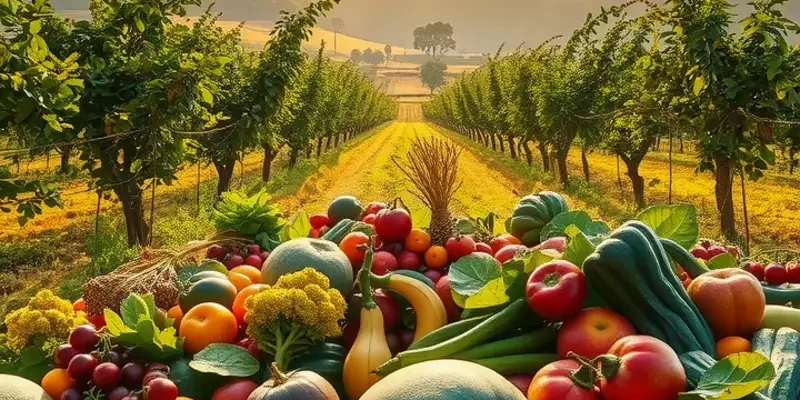Migration has long been a catalyst for culinary evolution. As people traverse borders, they carry their culinary traditions with them, giving rise to vibrant fusions and unique flavors. These exchanges not only enhance local cuisines but also foster a rich tapestry of culinary heritage. Understanding how migration influences food culture offers a deeper appreciation for the diverse dishes we enjoy today, revealing stories of adaptation, resourcefulness, and community.
Tastes of Tradition: How Flavors Travel

The story of migration is intertwined with that of food. Over centuries, peoples’ movements across continents have carried seeds, spices, and culinary techniques, creating a tapestry of flavors that know no borders. The spice trade, originating as early as 3000 BCE, laid the foundation for a global exchange that transformed cuisines far and wide.
Consider the ancient Silk Road, a network that extended from China to the Mediterranean, spanning over 4,000 miles. This route was instrumental in disseminating noodles from Asia, which adapted into Italy’s beloved pasta. Similarly, sugarcane, native to Southeast Asia, traveled through India and the Middle East, eventually reshaping European desserts upon its arrival.
On the grand scale, the Age of Exploration starting in the 15th century accelerated this exchange. As explorers set sail, they introduced and exchanged crops like potatoes and tomatoes from the Americas, reshaping European diets forever. The humble chili pepper, native to the New World, became a cornerstone of cuisines across Asia and Africa, exemplifying how ingredients transcend boundaries. Culinary influences through trade are just one way flavors travel and merge, weaving cultures together.
With the forced migration of enslaved Africans, American cuisines were left indelibly enriched by African influences. Ingredients like okra and black-eyed peas entered the Southern culinary repertoire, giving rise to dishes that speak of resilience and cultural synthesis.
Migration stories are imbued with the legacy of flavor. Immigrants carry with them cherished recipes and techniques that redefine foreign lands. For instance, Indian workers in the 19th century brought curries to the Caribbean, creating a unique Indo-Caribbean fusion. Chinese laborers in the Americas melded their traditions with available ingredients, giving birth to favorites like chop suey.
The 20th century saw waves of migration spurred by global conflicts and economic opportunities. With them, flavors such as Middle Eastern spices accompanying refugees, and Southeast Asian herbs finding roots in Western countries enriched local kitchens. Each migration wave contributed new layers, where adaptation was essential for survival and assimilation.
Through migration, food becomes more than sustenance; it becomes a canvas where nostalgia and innovation meet. The exchange of recipes is a form of communication where immigrants find connection and comfort. These dishes, initially representing homes left behind, often evolve, reflecting the new cultural landscapes they inhabit.
As these ingredients continue to journey across borders, they dissolve geographic boundaries, building understanding and appreciation for diversity. These travels ensure that traditional flavors, though adapted, are preserved, allowing each generation to rediscover and celebrate a shared human history anchored in taste.
Fusion of Cultures: Culinary Innovations from Migration

Migration has been a vibrant catalyst for culinary innovation, creating dishes that are not only rich in flavor but also in history. When people move, they bring with them not just their possessions but also their culinary traditions. This often results in the delightful fusion of different flavor profiles, textures, and cooking methods.
One quintessential example is the popular dish bánh mì, a Vietnamese baguette sandwich. Originating during the French colonial period, bánh mì combines traditional French baking with Vietnamese flavors. The delicate, airy texture of the bread stems from French influence, while the fillings—such as cilantro, pickled vegetables, and pâté—reflect the vibrancy and freshness of Vietnamese cuisine. As waves of Vietnamese immigrants settled in various countries, bánh mì adapted to incorporate local ingredients, offering variations such as grilled pork or tofu filling to cater to vegetarian preferences.
Another notable dish is chicken tikka masala, often hailed as a symbol of Indian-British culinary fusion. While its exact origins are debated, many attribute its creation to South Asian chefs in Britain who sought to cater to local tastes. This dish represents a blend of Indian spices with a curry sauce more akin to Western palates. The creamy, tomato-based sauce that envelops the richly spiced chicken pieces offers a taste profile that has become beloved in the UK and beyond, showcasing how adaptability can result in iconic dishes.
Moving across the Atlantic, chimichurri is another example of culinary interchange. Argentinean by fame, this vibrant green sauce reflects Argentina’s immigrant history, particularly from Spain and Italy. While chimichurri traditionally accompanies grilled meats, its herbaceous blend of parsley, garlic, oregano, and vinegar is used as a flavor enhancer in many other cuisines. For those interested in maximizing flavor without excessive salt, exploring alternatives like chimichurri offers an exciting sensory journey.
These examples highlight how immigrant communities manage to preserve their culinary roots while embracing and incorporating new elements. The reconfiguration of traditional dishes using locally available ingredients not only maintains a connection with heritage but also introduces these flavors to a broader audience.
The beauty of this culinary fusion is often experienced in shared dining settings, where food becomes a social bridge, fostering understanding and appreciation across diverse cultures. It’s a testament to the adaptability of cuisine and how migration continues to enrich and diversify global food traditions.
Final words
Migration has played an invaluable role in shaping the culinary landscapes across the globe. The amalgamation of different traditions, ingredients, and cooking methods creates a unique food culture that embodies the history and resilience of communities. By embracing these rich narratives, we gain a greater understanding of the dishes we savor. As we explore new foods influenced by migration, we affirm our connection to the diverse world around us. The next time you enjoy a global dish, remember it’s not just about flavor—it’s about a shared journey through history, culture, and creativity.








